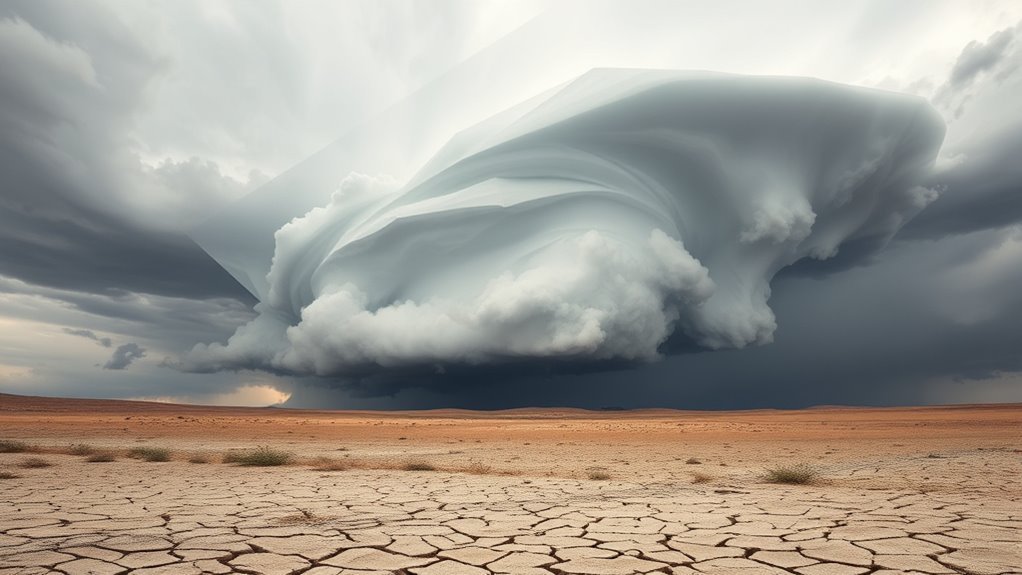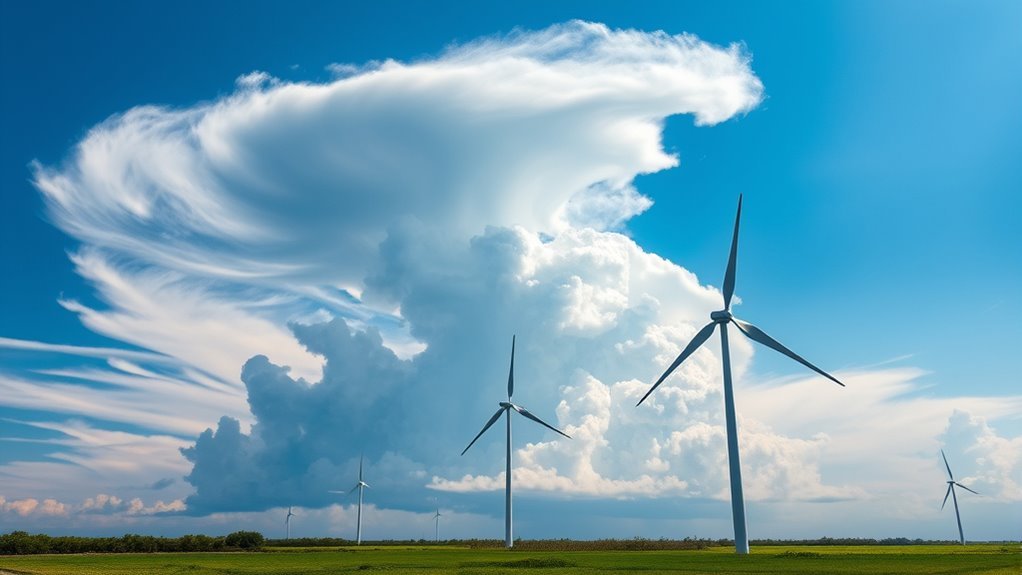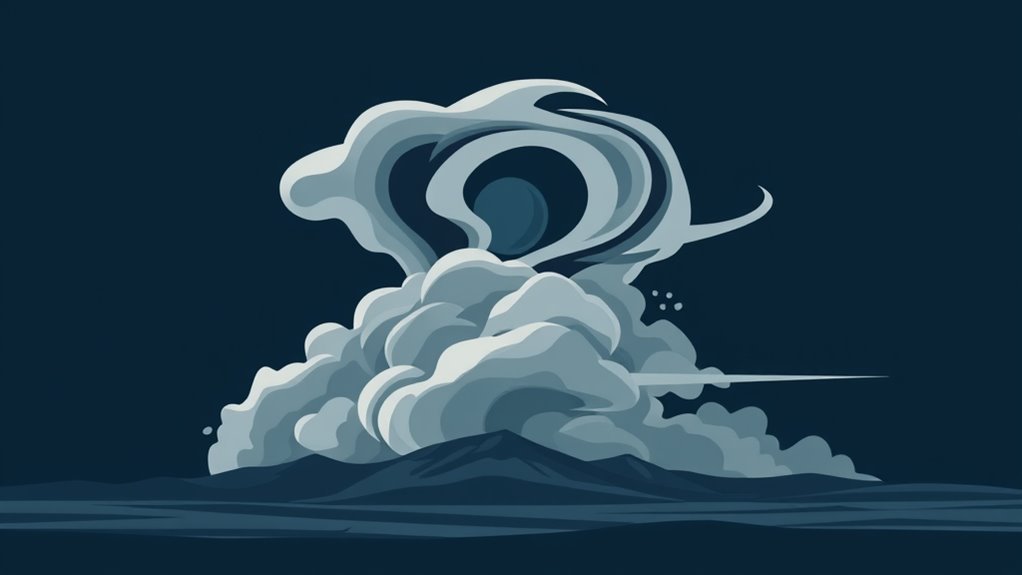Extreme weather events, such as squalls, are becoming more frequent due to climate change. Rising global temperatures allow the atmosphere to hold more moisture, which intensifies precipitation and wind patterns. Additionally, human activities like urbanization and deforestation disrupt natural climates, further contributing to these extreme events. The interplay between warmer ocean temperatures and altered atmospheric conditions also plays a major role. Understanding these dynamics sheds light on the broader consequences for ecosystems and communities.
Main Points
- Rising global temperatures increase moisture in the atmosphere, leading to more intense squalls and extreme weather events.
- Changes in ocean temperatures enhance storm formation, contributing to the frequency and strength of squalls.
- Urbanization causes heat retention, which exacerbates extreme weather patterns, including squalls.
- Climate change alters atmospheric dynamics and wind patterns, facilitating severe thunderstorms that produce squalls.
- Human activities, such as deforestation and industrialization, disrupt natural environments, increasing the likelihood of extreme weather events.
Understanding Squalls: Characteristics and Impacts
What exactly constitutes a squall, and how does it affect the environment? A squall is defined as a sudden, brief increase in wind speed, often accompanied by precipitation. Typically lasting less than an hour, squalls can produce winds exceeding 30 knots, leading to turbulent conditions.
Their sudden onset can disrupt marine and aerial operations, posing risks to navigation and safety.
In terms of environmental impact, squalls can cause rapid changes in temperature and humidity, affecting local ecosystems. The intense rainfall associated with squalls can lead to flash flooding, erosion, and the disruption of natural habitats.
Additionally, the strong gusts can uproot trees, damage infrastructure, and alter terrains. As a result, squalls play a crucial role in local weather systems, emphasizing the need for effective monitoring and preparedness strategies to mitigate their effects on communities and the environment.
The Role of Climate Change in Weather Patterns

As climate change continues to reshape global temperatures and weather systems, its influence on weather patterns has become increasingly evident. Rising atmospheric temperatures contribute to the intensification of weather events, altering the frequency and severity of storms, including squalls. Warmer air can hold more moisture, leading to increased precipitation during these events, which often results in flooding and other related hazards.
Additionally, climate change affects jet streams and ocean currents, disrupting established weather patterns and causing unusual shifts in climate zones. This unpredictability can lead to extreme weather anomalies, such as prolonged droughts followed by intense storms.
Regions that previously experienced moderate weather are now witnessing more extreme fluctuations, with heatwaves and severe cold snaps becoming more commonplace. Consequently, the interplay between climate change and weather patterns highlights a growing concern for communities worldwide, as they adjust to an increasingly volatile climate.
Human Contributions to Extreme Weather
Human activities considerably contribute to the increasing frequency and intensity of extreme weather events. Industrialization, deforestation, and urbanization have greatly altered natural environments, leading to disruptions in local climates. The burning of fossil fuels releases large amounts of greenhouse gases into the atmosphere, enhancing the greenhouse effect and causing global temperatures to rise. This warming influences atmospheric conditions, contributing to more severe storms, heatwaves, and heavy rainfall.
Agricultural practices, including land conversion and excessive water usage, further exacerbate climate change by reducing the land's ability to absorb carbon. Additionally, urban heat islands, formed by concrete and asphalt, intensify local temperatures, affecting weather patterns.
These human-induced changes not only raise the likelihood of extreme weather but also impact ecosystems, biodiversity, and human livelihoods. As society continues to grapple with the consequences of these actions, the urgency for sustainable practices becomes increasingly clear.
The Science Behind Increased Squall Frequency

While various factors contribute to the increasing frequency of squalls, climate change plays a vital role in altering atmospheric dynamics. Rising global temperatures improve the moisture-holding capacity of the atmosphere, leading to more intense and frequent storms. Warmer air can hold more water vapor, resulting in increased precipitation during squall events.
Additionally, the warming of ocean surfaces fuels stronger wind patterns, which contribute to the development of squalls. Changes in wind shear—variations in wind speed and direction at different altitudes—are also linked to climate change. Improved wind shear can aid in the formation of severe thunderstorms that produce squalls.
Moreover, shifts in jet stream patterns may lead to prolonged periods of instability in weather systems, heightening the likelihood of squall formation. Collectively, these interconnected factors underscore the scientific basis for the rising occurrence of these extreme weather events, signaling a notable shift in atmospheric behavior influenced by climate change.
Regional Variations in Extreme Weather Events
The impact of climate change on extreme weather is not uniform across the globe, leading to substantial regional variations in the types and frequencies of these events.
In coastal areas, rising sea temperatures contribute to more intense hurricanes and tropical storms, while regions experiencing prolonged drought face increased occurrences of wildfires.
The Midwest, known for its fertile land, has witnessed more frequent severe thunderstorms and tornadoes, exacerbated by changing atmospheric conditions.
Meanwhile, areas like the Mediterranean have reported intensified heatwaves and reduced rainfall, affecting agriculture and water supply.
Each region's unique geographical and climatic factors shape its vulnerability to specific extreme weather patterns.
These variations underline the complex interplay between climate change and local conditions, necessitating tailored approaches to understanding and addressing the consequences of extreme weather events in different areas.
As the climate continues to evolve, these regional disparities are likely to become even more pronounced.
Preparing for and Responding to Squalls
As squalls can develop rapidly and bring sudden changes in weather conditions, effective preparation and response are vital for minimizing their impacts. Individuals and communities should prioritize monitoring weather forecasts and alerts from reliable sources to stay informed about potential squall development.
Establishing emergency plans that include designated meeting points and communication protocols can improve safety during such events. For those in flood-prone areas, maintaining clear drainage systems and having emergency supplies, such as food, water, and first-aid kits, is essential.
Additionally, making sure that vehicles are equipped with emergency kits can aid in safe travel during adverse conditions. Public infrastructure should also be designed to withstand the intense winds and rain associated with squalls.
Local authorities must conduct regular training exercises and drills to guarantee readiness among emergency responders. Through proactive measures, the risks associated with squalls can be greatly reduced, protecting lives and property.
The Importance of Climate Action and Awareness
Recognizing the urgent need for climate action and awareness is essential, especially in the face of increasingly frequent extreme weather events. As squalls and other severe weather phenomena become more common, the consequences of climate change are laid bare.
Individuals, communities, and governments must acknowledge that proactive measures can mitigate these effects.
Climate action encompasses a range of initiatives, from reducing carbon emissions to promoting sustainable practices. Public awareness plays a critical role in galvanizing support for these measures, enabling citizens to make informed choices and advocate for policy changes.
Education about climate science encourages a deeper understanding of the issues at hand, promoting collective responsibility.
Increased awareness can drive innovation and investment in renewable energy sources, creating a more resilient infrastructure.
In the end, a unified approach to climate action is essential to combat the escalating impacts of extreme weather, ensuring a safer and more sustainable future for all.
Common Questions
How Do Squalls Differ From Other Types of Storms?
Squalls are brief, intense storms defined by sudden wind shifts and heavy precipitation, differing from other storms in their rapid onset and short duration. They typically occur in warm, moist conditions, contrasting with longer-lasting weather systems.
What Is the Historical Frequency of Squalls?
Historically, squalls have been documented for centuries, with their frequency varying by region and season. Records indicate that maritime areas, in particular, experience these sudden storms more often, often leading to hazardous conditions for sailors.
Are Squalls More Common in Certain Seasons?
Squalls tend to occur more frequently during changeable seasons, particularly spring and autumn. These periods often feature fluctuating temperatures and atmospheric instability, which can improve the likelihood of sudden, intense weather phenomena like squalls.
Can Squalls Occur Without Warning?
Squalls can indeed occur without warning, often developing rapidly due to sudden atmospheric changes. Their unpredictable nature makes them challenging to forecast, leading to potential hazards for those unprepared for such abrupt weather events.
What Are the Economic Impacts of Squalls?
The economic impacts of squalls can be considerable, causing damage to infrastructure, disrupting transportation, and leading to increased insurance claims. Businesses may face losses due to operational downtime and decreased consumer activity during severe weather conditions.

